
This resource was created by the Washington Office of Superintendent of Public Instruction.
- Subject:
- Mathematics
- Material Type:
- Assessment
- Homework/Assignment
- Lesson
- Author:
- Hannah Hynes-Petty
- Date Added:
- 03/31/2020

This resource was created by the Washington Office of Superintendent of Public Instruction.
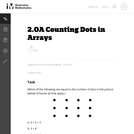
Students who work on this task will benefit in seeing that given a quantity, there is often more than one way to represent it, which is a precursor to understanding the concept of equivalent expressions.

This task applies geometric concepts, namely properties of tangents to circles and of right triangles, in a modeling situation. The key geometric point in this task is to recognize that the line of sight from the mountain top towards the horizon is tangent to the earth. We can then use a right triangle where one leg is tangent to a circle and the other leg is the radius of the circle to investigate this situation.
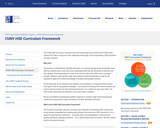
The CUNY HSE Curriculum Framework provides direction, structure and materials for teaching math, science and social studies (integrated with reading and writing) in the new era of HSE instruction. The complete framework is available for free download.
The framework was written by the CUNY Adult Literacy PD Team to respond to the challenges facing high school equivalency (HSE) teachers and their students. It is a guide for planning your instruction – including topic recommendations, model lessons, guiding questions, readings, and problems. The framework prioritizes depth over breadth. It does not address all of the content that might potentially be included on an HSE exam, but instead models a focused and coherent study of high priority topics within each content area.
As teachers in adult literacy and HSE education, our work has always been demanding. Now that our students face a new and more challenging HSE test, the demands on teachers are even greater. Teaching students to read, write and do math at the HSE level is no longer enough. Students need specific, deep and coherent content knowledge, as well as the capacity to apply this content knowledge to analysis and problem solving.
As the demands on our students and teachers are increasing, it is important that we don’t lose sight of one of our greatest strengths — our practice of starting from where students are and our serious respect for their learning processes. As a student of ours once said, “You can’t make a plant grow by pulling on it, you only make it rootless.”
The Social Studies section integrates reading and writing through a focus on U.S. history, with extensions to civics, economics and geography. This section has a curriculum map, 12 unit descriptions, six model lesson plans and additional resources.
The Science section provides an introduction to matter and basic chemistry with extensions to science/math connections. This section includes a curriculum map with 23 topic descriptions and key questions, and three complete inquiry-based model lesson plans.
The Math section focuses on problem-solving in functions and algebra. It integrates problem-solving strategies, productive struggle, perseverance and mathematical discussion into content learning. This section includes a curriculum map, model lessons, rich engaging math problems, samples of student work, powerful routines for math classrooms, classroom videos, and more.
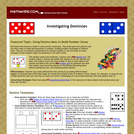
Dominoes have become a staple in most primary classrooms. They build upon dice patterns and are often used to model decomposition of numbers, building student knowledge of addition facts. They are an excellent manipulative for primary students to use and these are some examples of how students might use dominoes in the math center. Try these domino games with students to improve math skills and number recognition. Encourage students to play these games at home with their families, using real dominoes or paper copies.

These virtual learning resources were created to adapt the course for virtual learning, and shared by mathematics educators from around the state for your use.

These virtual learning resources were created to adapt the course for virtual learning, and shared by mathematics educators from around the state for your use.
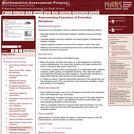
This lesson unit is intended to help teachers assess how well students are able to: articulate verbally the relationships between variables arising in everyday contexts; translate between everyday situations and sketch graphs of relationships between variables; interpret algebraic functions in terms of the contexts in which they arise; and reflect on the domains of everyday functions and in particular whether they should be discrete or continuous.
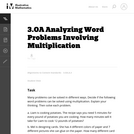
In this task, the students are not asked to find an answer, but are asked to analyze word problems and explain their thinking. In the process, they are faced with varying ways of thinking about multiplication.

Additional practice problems and activities to support the mathematical content in MOWWM Unit 6: The Arts - Topic 1

These virtual learning resources were created to adapt the course for virtual learning, and shared by mathematics educators from around the state for your use.

Additional practice problems and activities to support the mathematical content in Civic Readiness.
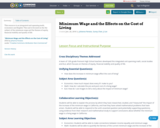
This resource is an integrated unit spanning math, economics and English. This unit is focused on the the subject of the minimum wage and the themes of equity, financial stability and quality of life.

This seminar will teach you about the Pythagorean Theorem. It will also teach you how to use the converse of the theorem and how to identify Pythagorean triples. You will have to apply the techniques you have learned to simplify radicals, and you will learn how to apply exponential properties. You will be shown visual demonstrations of the Pythagorean Theorem and be asked to connect them to the algebraic models of the Theorem.StandardsCC.2.3.8.A.3.Understand and apply the Pythagorean Theorem to solve problems.
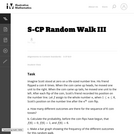
This task provides a context to calculate discrete probabilities and represent them on a bar graph. It could also be used to create a class activity where students gather, represent, and analyze data, running simulations of the random walk and recording and then displaying their results.

Additional practice problems and activities to support the mathematical content in MOWWM Unit 6: The Arts - Topics 2 & 3.

These virtual learning resources were created to adapt the course for virtual learning, and shared by mathematics educators from around the state for your use.

Additional practice problems and activities to support the mathematical content in Finances for Life.

Students solve decimal multiplication and division problems related to the basic fact 3 × 7 = 21.Students match cards that represent word problems, visual models, and numerical solutions to problems that include the numbers 0.8 and 0.2 for all four operations.Key ConceptsNo new mathematics is introduced in this lesson. Students apply their knowledge about decimal operations.Goals and Learning ObjectivesUse reasoning and mental math to solve problems.Solve word problems involving simple addition, subtraction, multiplication, and division with decimals.
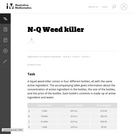
The principal purpose of the task is to explore a real-world application problem with algebra, working with units and maintaining reasonable levels of accuracy throughout.